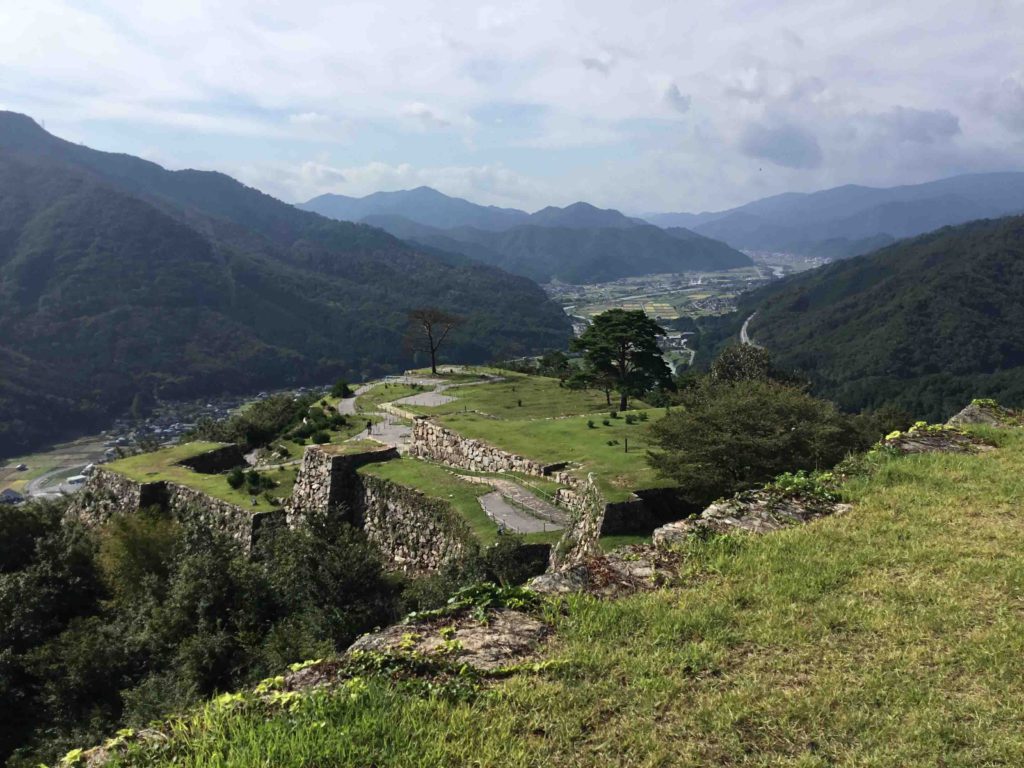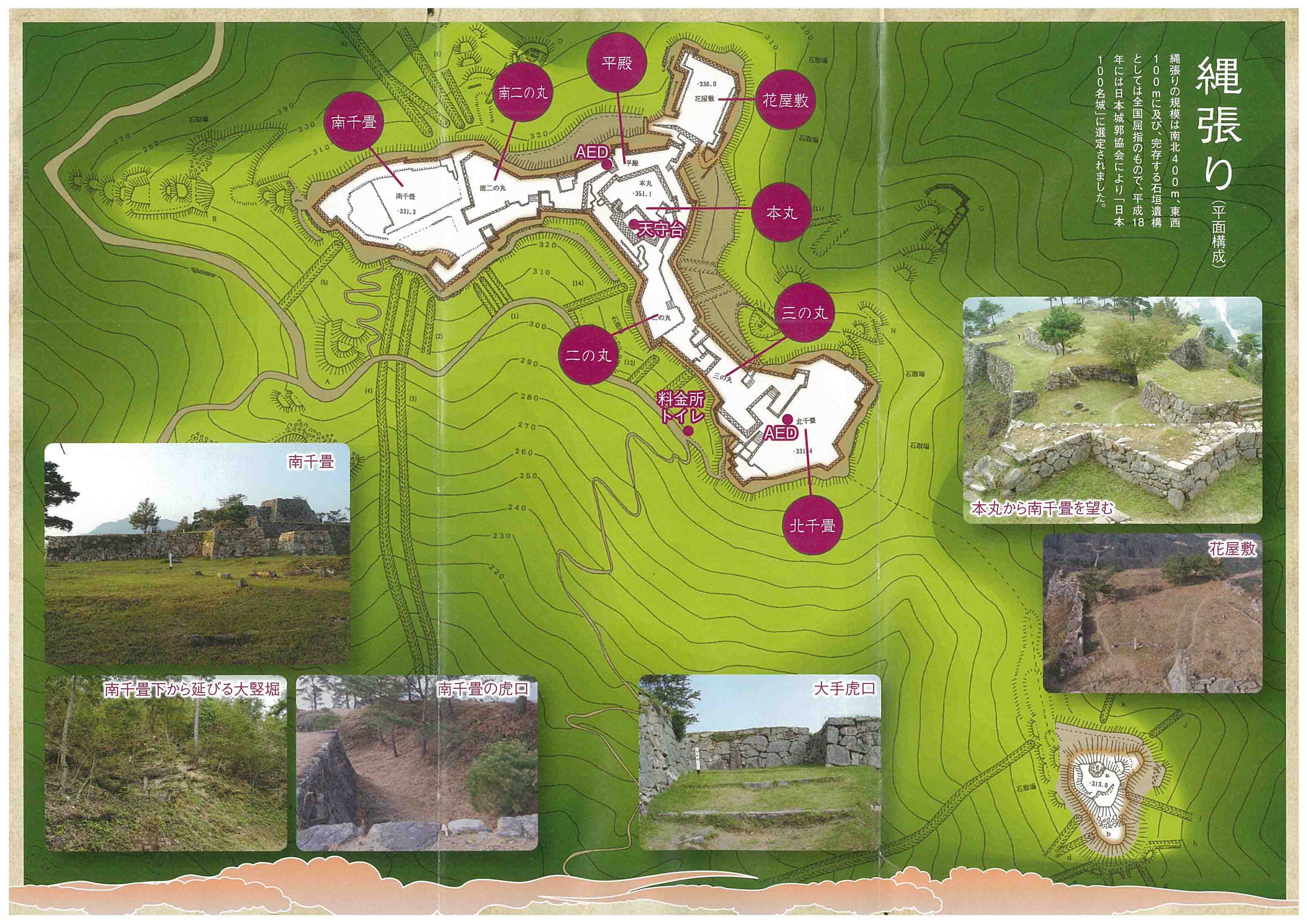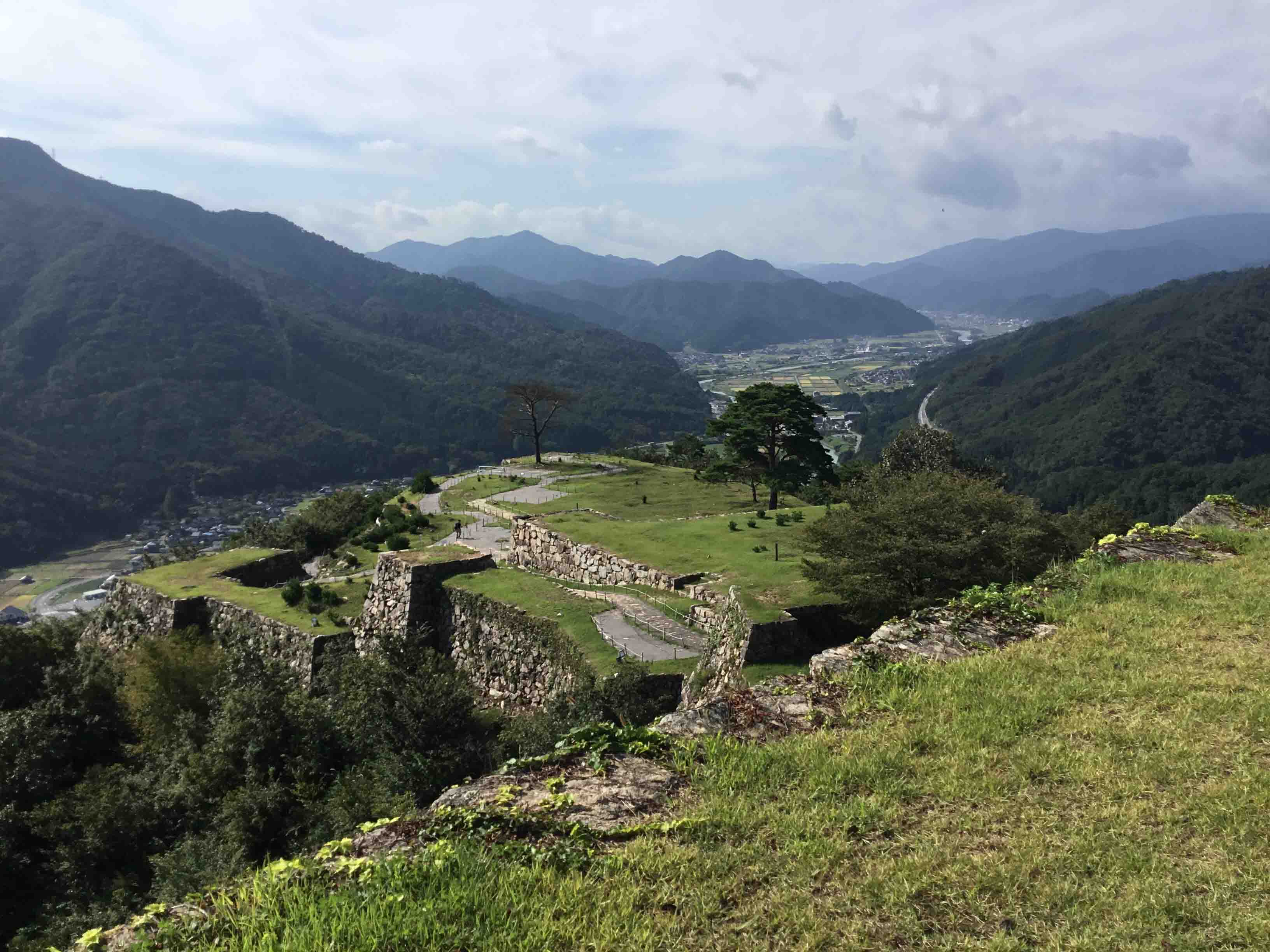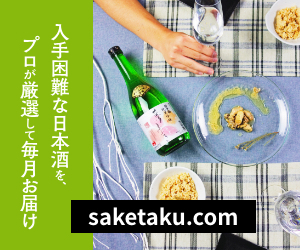- Home
- My Trip Diary
- Known at Honmaru What is the real beauty of Takeda Castle
Known at Honmaru What is the real beauty of Takeda Castle
- 2018/9/2

Good day!
Thank you very much for visiting this blog.
Today is the third part of Takeda Castle.
The picture above is from a guide leaflet which shows the territory of Takeda Castle.
I added this map to make this article easier to imagine. Please refer to this map while you are reading this article.
By the way, normal maps place the north at the top, but the north is the bottom right in the map above, maybe because to make the castle’s property look easier.
In the last blog, I used 4 movies of “Kita Senjo” which locates at the north of the castle, and I added some comments to them. As well as the last time, I’d like to use some movies to introduce “San no Maru”, “Ni no Maru”, “Honmaru”, and “Minami Senjo”.
Contents
Takeda Castle “San no Maru”
The first one is “San no Maru” (where the third main area of the castle was).
Very first part of the movie shows a zigzag street, and this is “Masugata Koguchi”. As you can see, the soldiers who invaded the castle got attacked one-sidedly from the surrounding walls when they came to this place.
After this area, there are stairs.
My pace slows down here because the stairs were steep and they are designed to be hard to climb.
I’m 174cm tall, and the average height of people in the age of civil wars is said to be not more than 160cm, so I imagine that it was even harder for the people in those times.
The building which appears in the last 30 seconds is “San no Maru”.
Because this castle is built on a mountain, it looks smaller than those on flat areas.
However, the view is so wide, so it is very convenient to recognize enemies who come from the southeast.
By the way, the road which goes to the back in the movie is Prefectural Route 277, which I had driven on to Takeda castle.
Takeda Castle “Ni no Maru”
The next is “Ni no Maru” (where the second main area of the castle was).
This movie starts when I turn right at the end of “San no Maru”.
A stonewall can be seen ahead of the street, and the street turns left there.
After turning left, an open area comes and you can see mountains.
There was a gate called “Ni no Mon” in those times.
In addition, there is another stonewall at the left of the gate’s place (you can see it only little in the movie), and this area is also “Masugata Koguchi”.
The mountain which you can see at the open area is “Ritsuunkyo”, which is the view spot of Takeda Castle in the cloud sea, and I introduced it in the time before last.
After going further, the next stonewall is ahead, and the top of this wall is Takeda Castle’s “Ni no Maru”.
The camera climbs up to “Ni no Maru”, and it shows from the left to right; the east to the south.
The area where you can see stonewalls at a little far from the spot is called “Minami Senjo”, and it is a pair of “Kita Senjo” which I introduce in the last blog.
The high stonewall after “Minami Senjo” is Tenshudai (the base of the main tower) of Takeda Castle.
To “Honmaru”
Let’s go to “Honmaru” (where the main palace of the castle was) next.
The camera turns back once, and you can see “Kita Senjo” ahead and the city of Wadayama Cho over.
Though the stairs of the top in the last part goes up to the base of Tenshukaku (the main tower), I’m not in “Honmaru” yet at this point.
There were other visitors there, so I stopped shooting once.
After the people were gone, I started again and took this movie below until I got to “Honmaru”.
How is the view from Tenshudai?
The movie doesn’t show it well because it’s vertical, but it’s actually a 360 degrees great view with no obstruction.
Tenshudai of Takeda Castle
Now, I’d like to explain the movie and Tenshudai of Takeda Castle a bit.
The flat area in the first few seconds of the movie is “Honmaru”.
As well as “San no Maru”, it looks smaller than normal castles’ “Honmaru” because Takeda Castle is castle on a mountain.
And the stonewall on “Honmaru” is Takeda Castle’s Tenshudai.
According to the map, there were not stairs on Tenshudai itself, so probably people climbed up Tenshudai from the stonewall at the south side or a big turret at the north which appears a little in the last part of the movie.
I think stairs were made on Tenshudai now to protect other walls.
Tenshudai and “Tenshukaku” is a pair.
Now it’s only walls as you can see, but there was Tenshukaku here when the castle was alive.
If you see the picture below,
This is the reference point at the center of Tenshudai, and there is a lonely stone in the top right in the picture.
It can be imagined that this stone at the top right was the cornerstone which was used at constructing the castle, and probably a post was on the stone.
The real beauty of Takeda Castle Ruins
The voice you hear in the middle of the movie is the radios of the people who maintenance the castle.
There was a lady at Tenshudai, and she told me many stories about Takeda Castle.
The most impressive story for me was the one to tell why the stonewalls of Takeda Castle are remaining in such as good condition.
Many people should think that historical heritages remain as long as human doesn’t destroy them.
However, historical heritages are to disappear or get covered with soil when they are not taken care of.
Then, why does Takeda Castle still have such beautiful walls?
That is because the local people have tried to keep the castle ruins.
It is a common idea now that such castle ruins can be important tourist attractions, so it is a kind of natural that castles are taken care of.
However, in Takeda Castle’s case, the people have kept maintenance of the castle for more than 300 years since the Edo period.
There is a story that the lord of the castle (I forgot the name…. In the age of civil wars, Terunobu Otagaki, Shigeharu Kuwayama, and then Hirohide Akamatsu played the lord, and the castle became like the latest structure in the time of Akamatsu.) developed the area around the castle for the citizens, and also the lord planted cherry trees in Ritsuunkyo to entertain the people.
The people respected the lord, and they kept taking care of the castle’s walls.
It is easy to do continuous efforts for financial reasons or for personal profits.
It is so impressive that the people have done hard works for generations without such material rewards.
I was moved by this story, and my heart was washed by this beautiful episode.
I viewed again the range of walls of Takeda Castle after hearing such stories.
I felt that this is beautiful and valuable not only because it’s good buildings, but also because of the inheritance of people’s heart for more than 300 years, which is more valuable than any others.
Well, it’s already been very long by now again^^;
It’s about 3,000 letters now, so I will write about “Honmaru” to “Minami Senjo” in another time.
Please visit again and check it!
It's our great pleasure if this article is helpful for you.
Restaurant Information
| Shop Name | |
|---|---|
| Prefectures | - |
| Tel | |
| Address | |
| Nearest Station | |
| Homepage | - |
| Business Hours | - |
| Holiday | |
| Introduction | |
| Sake List |
|




